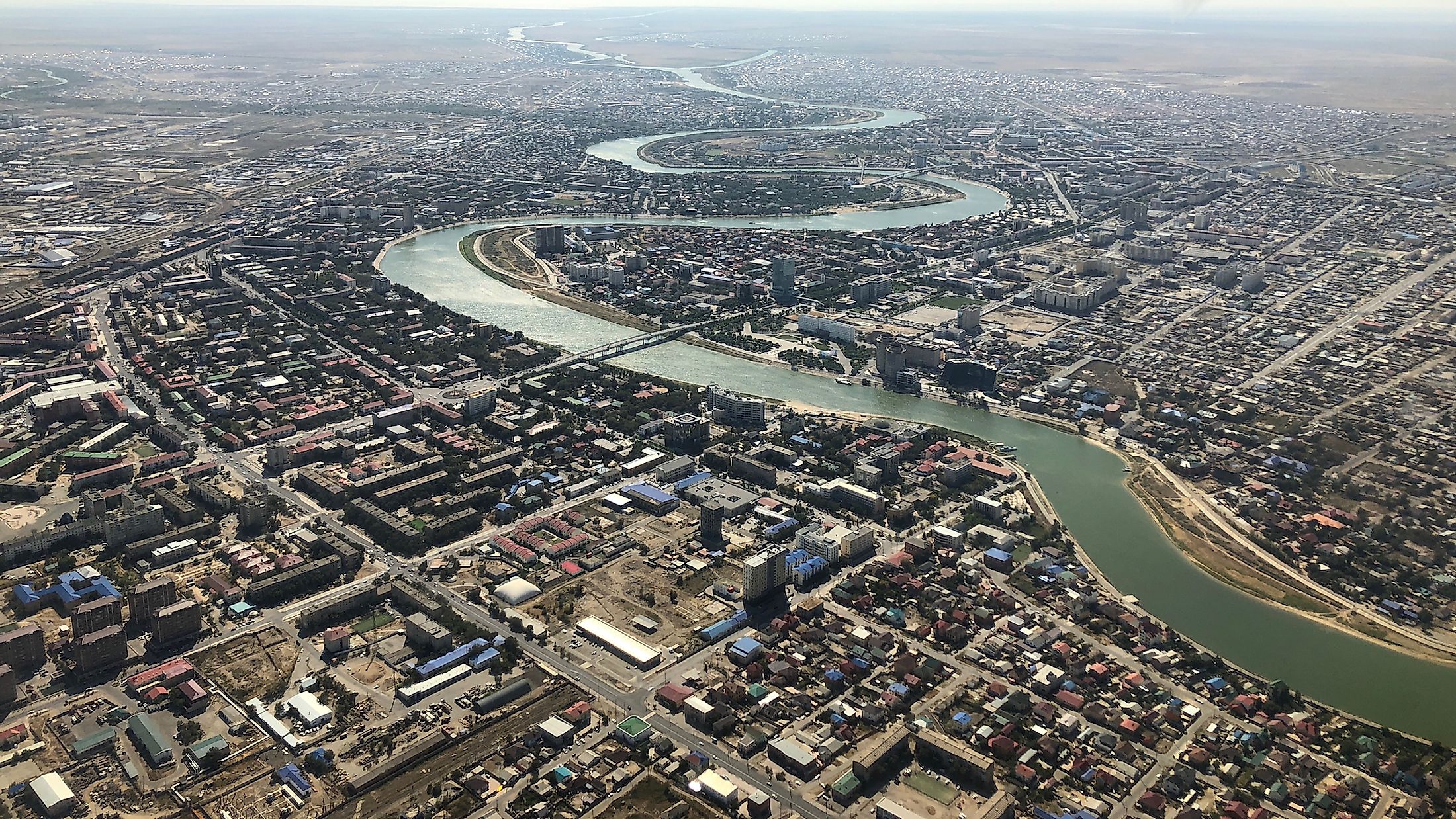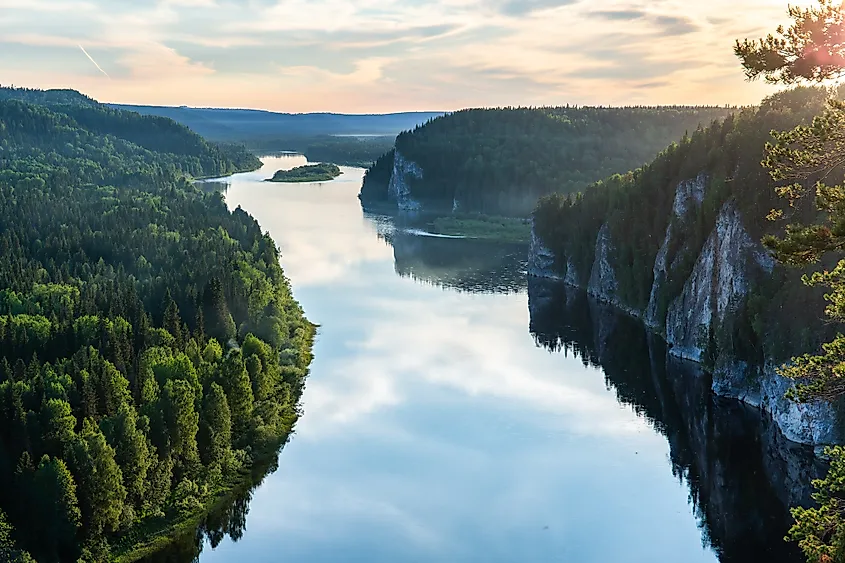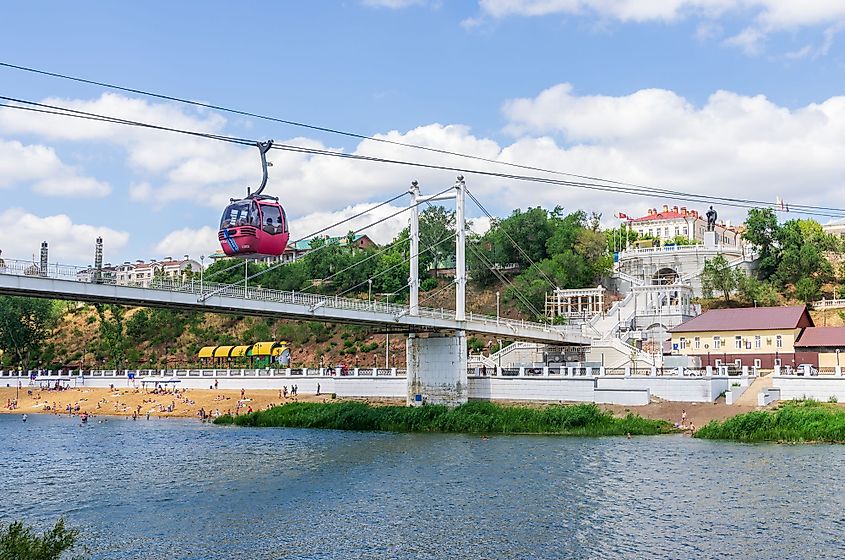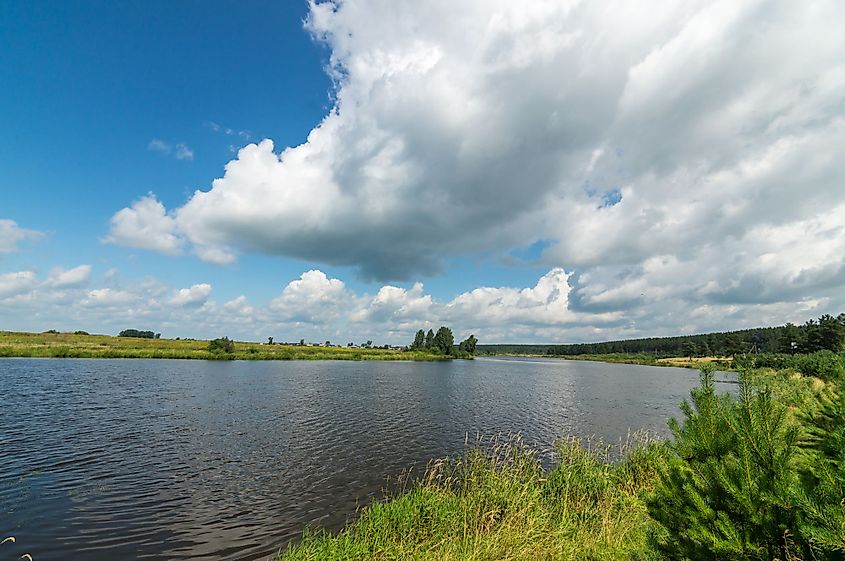
Ural River
Also referred to as the Zhayyq river in the native Kazakh language, the Ural River is a 2,428 km long river that flows through Russia and Kazakhstan along the continental boundary between Europe and Asia. The Ural River has an average width of 60 to 80 meters and shares many characteristics as other mountain rivers. The river originates at the Ural Mountains close to Mount Kruglaya in Russia and empties into the Caspian Sea, the world’s largest inland sea that lies between Europe and Asia. It is Europe's third-longest river after the Volga and the Danube rivers, and Asia's 19thlongest river. A prominent feature of the Ural River is its digitate delta, or tree-like structure, that can be seen as the river enters the Caspian Sea. The Ural River bridge in Orenburg, Russia is labeled with permanent monuments carved with the words “Europe” and “Asia” on each side. The Ural River delta has been significantly modified to reduce flooding and divert water, just like the Mississippi River of the United States.
Course and Geography

The Ural River starts from the slopes of the Mount Kruglaya of the Uraltau Mountain ridge in Southern Ural, in the Russian Republic of Bashkortostan. It then flows in the southward direction, parallel to the Tobol River and through the industrial city of Magnitogorsk on the eastern side of the southern end of the Ural Mountain Range. After flowing around the southern end, the river turns towards the westward direction at the city of Orsk and flows for 45-kilometers through a long canyon in the Guberlinsk Mountains. The banks of the river from Magnitogorsk to Orsk are steep and rocky, and the bottom has many rifts. After Orsk, the river turns westwards and reaches its confluence with the Chagan River near the Russian border at Oral, northwestern Kazakhstan. At this point, the river tuns southwards again and flows across a lowland of semi-desert to enter the Caspian Sea through the Atyrau region in western Kazakhstan. In the Atyrau region, the river widens and has many lakes and ducts. The Ural River also splits into the Yaik and Zolotoy distributaries close to its mouth, allowing the formation of vast wetlands. This has also led to the formation of a prominent digitate delta, which usually forms in slow rivers carrying large amounts of sediments.The Shalyga Island, being 2.5 km long, is located about 13.5 km from the mouth of the Zolotoy distributary in the delta. The Ural River has total 58 tributaries, with the most prominent ones being Kushum, Derkul, Chagan, Irtek, Utva, Elek, Bolshaya Chobda, Kindel, Sakmara, Tanalyk, Salmys, Or and Suunduk. Tributaries from the right side are typical mountain rivers while the left side tributaries have flatland characteristics.
Hydrology and hydrography

Melting snow constitutes about 60% to 70% of the river’s water source, while precipitation is a minor source. Most of the annual discahrge of the river occurs during the spring floods that takes place in March and April near the mouth and from late April to June in the upstream. The average water discharge is 104 m3/s near Orenburg and around 400 m3/s at the Kushum village which is about 76.5km away from the mouth. The maximum discharge can reach up to 14,000 m3/s and a minimum of 1.62 m3/s. During the floods, the river increases in width to more than 10 km close to Uralsk and to several tens of kilometers close to its mouth. The Ural’s tributaries also play a role in supplying it with water, with the largest being the Sakmara, the Elek and the Chagan. The river’s source freezes in early November while the middle and lower reaches of the river freeze in late November.
The lower reaches melt in late March while the upper reaches melt in early April. The depth of the river is 1 to 1.5 meters near the source, but it increases as the river flows through the middle reaches and the mouth. Similarly, the richness and density of the underwater vegetation and fauna increases as the river progresses from source to mouth. The bottom of the upper reaches is rocky and carries pebble and sand, while in the downstream silt-sand and clay are found instead. There is a dangerous shipping spot called Kruglovskaya prorva, that is situated about 200 km from the mouth. At this point, the river narrows and generates a strong vortex over a deep pit.
Biodiversity

The wetlands created by the river’s delta are important for the migrating birds and acts as a stop-over point along the Asian flyway. These wetlands host many endangered species such as the great white Pelican, pygmy cormorant, greater flamingo, white-headed duck, Dalmatian pelican, ferruginous duck, glossy ibis, houbara bustard, squacco heron, demoiselle crane, tundra swan, short-toed eagle and many others.
The Ural River is also important for many fish species living in the Caspian Sea that migrate upstream for spawning. About 47 fish species belonging to 13 families are found in the lower reaches of the river. The main commercial species are Wels catfish, sturgeon, roach, perch, etc. There are also some rare species such as the sterlet, Caspian salmon and the Caspian kutum. The delta of the river and nearby regions are home to 48 animal species among which the rodents are the most common ones. Some mammalian species like the Bobrinski’s serotine and marbled polecat are endemic to the region.
History
The shores of the Ural River was inhabited by the Yaik Cossacks after the Russian conquest of the Ural basin in the late 16th century. The Ural River served as a significant source of fish, particularly true sturgeon, beluga sturgeon and starry sturgeon. Actually, the Yaik Cossacks gave the river its initial name - the Yaik River. However, the Yaik Cossacks rebelled against the Central government’s rules and regulations. The Pugachev’s Rebellion - the largest rebellion that involved the Ural and a major part of southeastern Russia, resulted in loss of governmental control there. After the suppression of the rebellion, Empress Catherine II of Russia issued a decree on January 15, 1775, to rename all the places involved in the rebellion as an attempt to erase its memory. Hence, the Yaik River and the city of Yaitsk were renamed as the Ural River and the city of Uralsk, respectively. This also changed the name of Yaik Cossacks to the Ural Cossacks.










